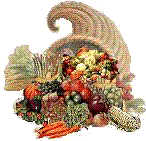
Free-Form Vegetable soup master recipe with variations
I think of vegetable soups as basically tomato-ey and otherwise. There is a tendency, especially when you start experimenting with soups made from stocks, broths, and juices, for them to taste all the same because they have pretty much the same things in them. Make them different! Take the lists below as suggestions, using different bases, vegetable combinations, and garnishes at different times.
Each quart of finished soup requires about 3 cups of raw vegetables and/or cooked beans or noodles and about 3 cups of some flavorful stock. A quart of homemade soup only serves about 3 people unless they are being polite.
Plan your additions so that the tenderest items go in last, and so that nothing will be over-cooked by the time the soup is ready. If you are making a very thick soup, simmer over low heat and stir it frequently to prevent scorching. If you use a meat or chicken broth, skim off most of the fat on it, the fat is what gives it the heavy taste many people dislike. However, if you are making a vegetarian soup without other fat, about 1-2 T of high quality vegetable oil per quart stirred in toward the end of cooking will improve it.
|
Water left from steaming or simmering vegetables; green beans or corn are especially goodb |
Soup Making Notes:
About the cabbage family: long cooking or high heat cooking of cabbage, broccoli, mustard, kale, brussel sprouts or cauliflower, or their cooking waters, causes a breakdown of their sulfur compounds, which givesd that familiar, undesirable cabbage-y boarding house smell.
The flavor, texture, and cooking time of the soup can be varied by changing the shapes into which you cut the raw vegetables. Leftovers should be added near the end or used to make stock.
Ingredients, especially vegetables, may be sauteed in oil or butter before adding, may be steamed or may be added raw. This changes the flavor of the finished soup.
|
onions
cauliflower broccoli asparagus cabbage |
|
These absorb liquid while cooking, thickening the soup, and will cook apart to a thick soup if left for a while. If you want them whole, add the pre-cooked starch the last 10-20 minutes of cooking.
Potatoes |
|
These ingredients stay solid or chewy throughout cooking
water chestnuts |
|
Add these near the end of cooking, just early enough that they are completely cooked before serving. The soup will thicken. Start stirring.
flour (before adding mix with cold liquid) |
|
Raw meat, other than ground or minced meat, is a good broth base. If added to the soup, it should be added very early so that it can be thorough tender by the time the rest of the soup is cooked. The tougher, cheaper, bonier cuts are
preferable because they have stronger flavor. Keep cooking temperatures at a simmer after meat is added. If you boil, rather than simmer, soups containing
meat, it will toughen the meat.
oxtails Before serving, remove the bones and skin from the meat, chop the meat and return it to the soup. Don't leave bones and skin, or too much fat, in the soup. Seafood, fresh fish, shrimps, clams and oysters need only 5 to 15 minutes to cook in soup. If you plan to leave them longer, be sure to keep the heat very low to avoid a really fishy taste. Ground meat also takes only a few minutes of cooking before it toughens. |
|
1 tablespoon fresh cold-pressed oil per quart.
Soy sauce Best I've found is a vegetable-soy bouillon called Dr. Bronner's Balanced Protein Seasoning. Not the mineral broth, but the protein powder bouillon. |
|
Must be added at the very end or they will become curdled or stringy. |
|
chopped parsley or Chinese parsley/ cilantro left-over vegetables or soup dumplings, either meat or grain |
